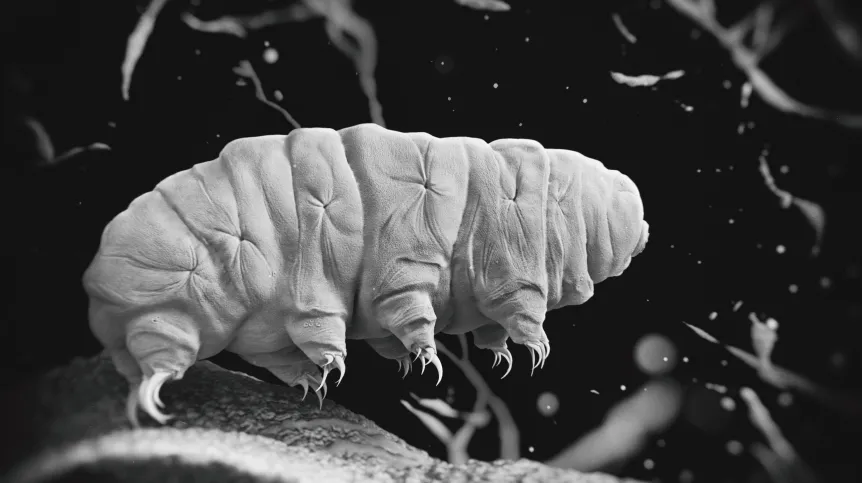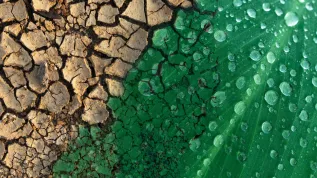
Cryptobiosis, or latent life, is an extraordinary mechanism because of the resilience it gives to organisms that can enter it. Learning the limits of this resilience is important, for example, in the context of astrobiology and whether any forms of terrestrial life are able to survive beyond our planet, said Dr. Weronika Erdmann from Adam Mickiewicz University.
For several years now, tardigrades have been one of the hottest topics in the world of biology. These tiny invertebrates that have gained fame thanks to their resistance to extremely unfavourable environmental conditions, are unparalleled among other multicellular organisms.
It has been proven that they can not only survive very long periods without food and water, withstand ionising radiation, extremely low and high temperatures, high pressures and salt concentrations, they can even survive for some time in space.
All this thanks to the fact that in the course of evolution they have developed a unique ability - cryptobiosis, also known as latent life. When they enter this state, their metabolism slows down to near zero. While they need water and food for active life, i.e. movement, growth and reproduction, in cryptobiosis they are able to survive for many years without these factors.
'The extraordinary resilience of tardigrades is not only due to their ability to enter a state of cryptobiosis, but also to the fact that they have developed special repair proteins which, when these animals return to an active state, repair most of the damage that occurred in their bodies during the said cryptobiosis with extraordinary effectiveness', says Dr. Erdmann, a specialist in astrobiology, geomagnetobiology, and tardigrade researcher. 'But because this is their response to living in relatively unstable environments, not all tardigrade species have these mechanisms developed to the same extent. The more stable the living environment, the less resistance to unfavourable environmental conditions', she describes.
For example, terrestrial species of genera such as Echiniscus, Mesobiotus and Milnesium are known for their high resistance to drying and to extremely high and low temperatures; in contrast, the cryptobiotic abilities of freshwater tardigrades of the genus Hypsibius are considered to be very low.
'It may seem strange to us that the mosses covering our forests or home walls are such an extreme environment that they required tardigrades to develop this type of adaptations. After all, we live in a temperate climate where we do not experience such extreme temperatures. Well, all this is true on a macro scale, but not on a micro scale. Because a single clump of moss, which is a habitat for thousands of tardigrades, rotifers and nematodes, dries out in summer and heats up to high temperatures well above the air temperature, while in winter a layer of water on its surface freezes easily. All you need is a small amount of bird droppings or salt from a nearby road to dramatically change the pH of the water, which is so important for the organisms living in the moss. Larger invertebrates, such as arthropods, can +emigrate+ when conditions become unfavourable, but small invertebrates, such as tardigrades, usually cannot. So they could only +learn+ to wait out these unfavourable periods. And that is what happened', says Dr. Erdmann.

The researcher's latest article, published in The European Zoological Journal (https://doi.org/10.1080/24750263.2024.2341884), concerned the discovery by her team of a new species of tardigrades of the genus Mesobiotus. Scientists named it Mesobiotus mandalori, after one of the characters in the Star Wars universe.
'The extraordinary resilience of tardigrades is not only due to their ability to enter a state of cryptobiosis, but also to the fact that they have developed special repair proteins which, when these animals return to an active state, repair most of the damage that occurred in their bodies during the said cryptobiosis with extraordinary effectiveness', says Dr. Erdmann, a specialist in astrobiology, geomagnetobiology, and tardigrade researcher.
'I have been a fan of science fiction since childhood. I fell in love with Star Wars when I was eight years old, and the Mandalorians are my favourite faction in this universe. I am a member of Manda'Yaim - the Polish Mandalorian Community. In addition, there are at least a few associations connecting the tardigrade species we discovered, and tardigrades in general, with Mandalorians', says Dr. Erdmann.

She mentions that, first of all, there is their extraordinary resilience, reminiscent of the Mandalorians' armour made of nearly indestructible beskar. 'Secondly, the place of life of the newly discovered species: it lives in trees, and the first ever depiction of Mandalore showed it as a planet covered with dense forests. The first (apart from Boba Fett) Mandalorians we met there lived in a settlement built among trees. Moreover, a name referring to pop culture is a great way to promote science', Erdmann adds.
Scientists found the new species during research conducted in the Czerniewo Forests. They explain that in the case of such tiny organisms, discovering new species is often a coincidence. 'When we search samples from areas that have been poorly studied for tardigrades, we actually usually hope to find something new there. But often, as in the case of our Mesobiotus mandalori, new species are described during other, broader studies, e.g. ecological ones', Erdman explains.
Meb. mandalori joined the group of 114 other tardigrade species occurring in our country and a total of 1,464 species from around the world. But - according to researchers - this value is probably one tenth of the entire global diversity of these organisms. These invertebrates live in all environments on Earth where there is at least some water: from the depths of the sea to the tops of mountains.
Among the species found in Poland, terrestrial tardigrades living in mosses and lichens dominate; there are also several freshwater species and a few marine species.
Dr. Erdmann emphasises that each of them is important for the preservation of biodiversity, although it is not always visible at first glance, especially at the scale we operate on a daily basis. 'Tardigrades are small invertebrate organisms, the body length of the largest species occurring in Poland does not even reach 1 mm. They feed mainly on soil bacteria, algae, rotifers and nematodes, sometimes other tardigrades. They operate on a micro scale. When we talk about the impact that a given organism has on the environment, we usually think about the macro scale', she says, adding: ’In some respects, this is still virgin research territory’.
The topic that Dr. Erdmann is most interested in at the moment is the search for subfossil remains (i.e. the remains of living organisms that died quite recently on the geological time scale, over the last 10,000 years) of tardigrades and assessing the possibility of their use as markers of palaeoenvironments.
In her opinion, studying tardigrades is worthwhile also because they can improve our understanding of the general mechanisms governing the distribution of small invertebrate animals.
'This is important because most research in this field focuses on much larger and often more mobile organisms. And as I have already said, tardigrades - like nematodes or rotifers - operate on a microscale and respond to a slightly different range of factors than macroorganisms (vertebrates or arthropods) living in theoretically the same environment', Erdmann says.
Few people know that tardigrades - despite their great resistance to unfavourable environmental conditions - are poorly resistant to mechanical damage, so the chances of their remains being preserved, e.g. in the form of fossils, are small.
'Their bodies lack skeletal elements that could be fossilised. On the other hand, because they are so small, they are more difficult to fragment. Thanks to this, some of their remains can be found in lake and peat sediments younger than 10-11 thousand years', says Erdmann.
However, there are very rare situations when researchers manage to find much older remains of these animals. The oldest ones come from the Cretaceous, specifically Turonian, approximately 90-93 million years ago. They were discovered in an amber from New Jersey.
'Although, unfortunately, the finds of this type can be counted on the fingers of one hand, they can be used to establish certain facts about the evolution of tardigrades. Thanks to this, we know that they are a very old group. It is speculated that their origins may date back to the Cambrian period, i.e. 485-541 million years ago', Erdmann explains.
She adds that the first representatives of all currently known types of animals emerged during that period. (PAP)
PAP - Science in Poland, Katarzyna Czechowicz
kap/ bar/ mow/
tr. RL













